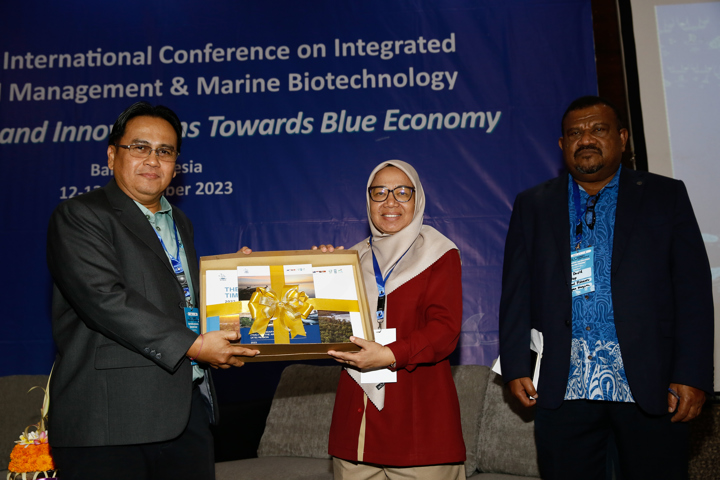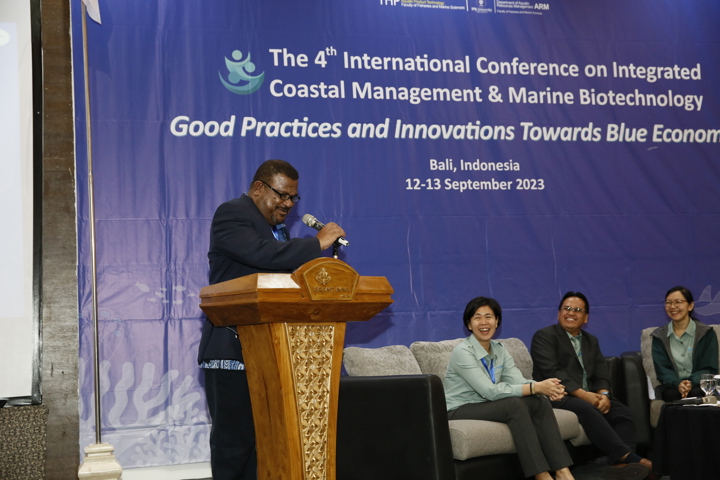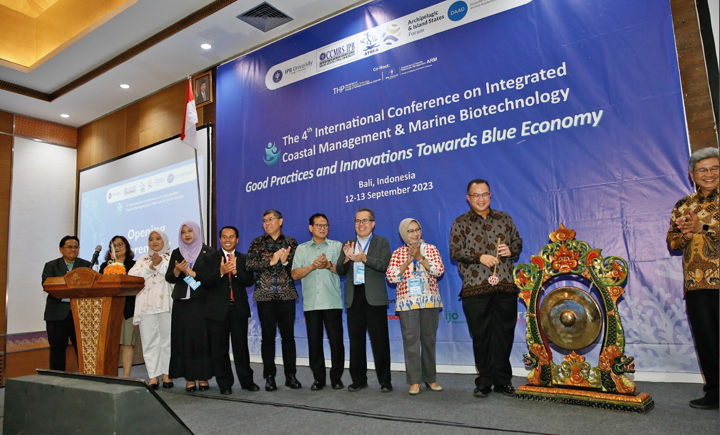ATSEA-2 hosts 4th International Conference on ICMMBT, launches key publications
The conference marks the start of the final year of the ATSEA-2 Project as it unveiled the updated 10-year Strategic Action Program (SAP) laying the groundwork for the 2024 Arafura and Timor Seas (ATS) Ministerial event. The conference likewise served as a platform showcasing key contributions to governance and biodiversity in the ATS region, including establishing a Regional Governance Mechanism (RGM) and gathering global experts for knowledge sharing and collaboration.
PEMSEA Executive Director Aimee Gonzales kicked off the event by underscoring the significance of the ATSEA-2 Project in promoting collaboration for environmental protection and sustainable development. She highlighted the Project’s key achievements and emphasized its interconnected nature, forming a shared vision for a long-term, country-owned collaboration guided by a common framework. Gonzales stressed the importance of these collaborative efforts to preserve the region’s marine heritage for future generations, aiming to provide valuable insights for policymakers and scientists in developing science-based policies and actions.
Launching the TDA and ATS Atlas

The conference featured the launch of two significant publications for sustainable understanding and management of the ATS region. The first is the updated TDA for the ATS Region, which assesses shared water resources. The second is the ATS Atlas, designed to be accessible to stakeholders and the public, providing detailed information on the region’s geography, climate, ecosystems, resources, species, and resource usage.
Dr. Handoko Adi Susanto, the ATSEA-2 Regional Project Manager, presented them to representatives from Indonesia, Papua New Guinea, and Timor-Leste as endorsed by PEMSEA and UNDP Indonesia through Iwan Kurniawan.
ATSEA-2 Project Plenary Session
Regional Biodiversity Specialist Casandra Tania and Policy and Results-based Management Specialist Cristine Ingrid Narcise discussed the interface of science and governance in strengthening the ATS ecosystem carrying capacity. Tania highlighted severe challenges in the ATS region, as noted by previous assessments in 2020 and 2021, such as unsustainable fishing practices, pollution, habitat deterioration, loss of critical species, and climate change impacts. She further emphasized the role of these assessments in shaping regional and local strategies, even contributing to updating the TDA and SAP, ensuring that management plans are rooted in scientific insights.
On the one hand, Narcise highlighted the successful establishment of the RGM to promote collaboration while securing funding among four ATS countries. She explained that “this is a crucial step towards shifting from a project-centric strategy to a sustainable, nation-driven regional partnership; looking forward, this model is slated for formal adoption by the countries through a ministerial forum in 2024."
Furthermore, Susanto illustrated how ATSEA-2 initiatives helped connect science to policies through the TDA-SAP process. He underscored that, “the TDA-SAP process, combined with the RGM as undertaken by ATSEA-2, provides an example of how science interfaces with governance to ensure a more holistic approach in setting clear and targeted collaborations and interventions.”

The plenary session concluded with representatives from ATS countries providing insights into the future of ATSEA-2. First, Ms. Yayan Hikmayani from Indonesia's Ministry of Marine Affairs and Fisheries (MMAF) highlighted the importance of the science-policy interface and how it has guided various initiatives in Indonesia. She reiterated the significance of regional governance in coordinating SAP and NAP implementation and reaffirmed Indonesia's commitment to updating its NAP. She ended by affirming Indonesia's dedication to working with ATS countries and expressed her hopes for the long-term success of the ATSEA Program.
Meanwhile, Mr. Pakop of Papua New Guinea emphasized the importance of regional cooperation in addressing coastal challenges in the ATS region. He likewise mentioned the Project’s trailblazing work in Papua New Guinea, especially being the newest member country, such as the artisanal fishery management plan and the first NAP. Pakop emphasized that the ATSEA Program aligns well with Papua New Guinea priorities and called on others to join in stating, "The ATS NAPs and SAP offer numerous opportunities for collaboration and means to propel the ATS region as a model for a thriving blue economy and a significant contributor to sustainable global targets."
"We appreciate the ATSEA-2 Program for providing us with the knowledge, skills, and resources to support the sustainable utilisation and development of Timor-Leste’s marine and coastal resources and fisheries," Mr. Celestino da Cunha Barreto, Director General of the Ministry of Agriculture and Fisheries (MAF), expressed in a video message. He hopes that the updated ATS SAP and RGM will guide collaborative efforts beyond completing the ATSEA-2 Project. Mr. Barreto likewise mentioned Timor-Leste's commitment to updating its NAP and how it adopted the Blue Economy approach for sustainable development. He concluded by expressing his eagerness to formalize partnerships at the ATS Ministerial Forum in 2024, which is set to be hosted by Timor-Leste.
Dr. Aprilia from UNDP Indonesia highlighted how the three key aspects of the ATSEA-2 Project are foundational for future ATS collaborations as he delivered the closing remarks. “We must recognize the importance of having current scientific knowledge, a strategic action plan, and a governance mechanism working together," she said. Lastly, she thanked all participants, organizers, and contributors for their dedication to preserving the region's oceans and coasts.
The event was organized by the Center for Coastal and Marine Resources Studies of IPB University (CCMRS-IPB) in close collaboration with the ATSEA-2 Project, the Archipelagic and Island States (AIS) Forum, and the German Academic Exchange Service (DAAD).
Read ATSEA-2's latest newsletter to know more about this event and its outcomes, and other latest news from the Project and the Arafura and Timor Seas.
***
About the ATSEA-2 Project
ATSEA-2 is the second phase of the Arafura & Timor Seas Ecosystem Action (ATSEA) program; a regional partnership involving the governments of Indonesia, Timor-Leste and Papua New Guinea, with the support of the Australian Government. Its objective is to collectively manage high marine and fisheries resources in the Arafura and Timor Seas (ATS) region. Since its inception in 2019, the program has been promoting sustainable development in the ATS region and improving its inhabitants' quality of life through a combination of restoration, conservation and sustainable management of marine-coastal ecosystems.
The ATSEA-2 Project is committed to safeguarding the livelihoods and prosperity of coastal people in the ATS region, particularly in transboundary areas, by implementing sustainable integrated concepts. ATSEA-2 is a Global Environment Facility (GEF)-funded program, managed and executed under the United Nations Development Programme (UNDP). Partnerships in Environmental Management for the Seas of East Asia (PEMSEA) Resource Facility (PRF) is an implementing partner.
For more information on the ATSEA-2 Project, please contact the Regional Project Manager, Handoko Adi Susanto (hasusanto@pemsea.org), visit the project page on iwlearn.net or the project website.


























